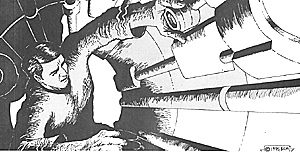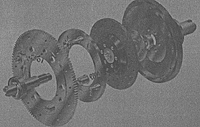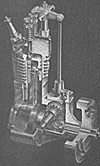 Captain!" shouted the engineer "The hyperspace inducer can't take that kind of pressure. The coil will atomize and we'll end up as space dust!"
Captain!" shouted the engineer "The hyperspace inducer can't take that kind of pressure. The coil will atomize and we'll end up as space dust!"
The captain turned a puzzled glance to the engineer, his eyes beetling behind dark glasses. "What the hell are you talking about?"
What, indeed, is he talking about? Well, as most sci-fi fans can tell you, it's the scientific jargon of the far flung future, and part of the flavor of any space opera setting. In teleplay shorthand it is called "tech" - short for "technobabble" - and despite the spice it adds to a story it's an ingredient often omitted from the roleplaying venue.
Why? Because despite its potential usefulness, it lacks any vehicle for its presentation.
For the purpose of developing a "technobabble" vehicle in role-playing, it is easiest to consider the whole range of "tech" when divided into three loose categories:
The first and most popular "tech" is doubletalk. Doubletalk comprises most of the science fiction "technical language" we see on television or on the big screen. It consists of large and/or unusual words that pertain to fictitious assumptions like "hyperspace" or "warp energy" which make the show run. Doubletalk language doesn't mean very much in and of itself and makes little attempt to be internally consistent. It usually serves to present the story characters with some sort of problem which must be dealt with through means outside the framework of technical language. (i.e. the warp phase inducer is busted, meaning the ship can't go anywhere until we get some unobtanium crystals to fix it.)
The second type of "tech", seen less frequently in TV and the movies but more frequently in books, is that which composes an internally logical set. For the sake of discussion I'll call this "singletalk". Like doubletalk, singletalk consists of outrageous terms which pertain to fictitious assumptions. Unlike doubletalk, however, singletalk is logically consistent with itself. This allows the characters to puzzle through "technical" difficulties which are actually logic problems. (i.e. we know that if the vaccine was working, our dermis would be producing "melanin-P". If we were producing "melanin-P" we would all have purple spots. We don't have purple spots therefore the vaccine isn't working correctly.)
Telling the difference between doubletalk and singletalk isn't always easy, but this rule of thumb applies: if, knowing only what you know as a viewer, you could have eventually puzzled out the solution to a "technical" problem, it's singletalk. If there simply weren't enough logical connections between the problem and,the solution for an outside viewer to solve the puzzle, it's doubletalk.
The third type of tech I will call "hard tech". Hard tech is language where characters engage in technical discussions of phenomenon which are "real", and have their roots in real world science. "Hard tech" is rarely seen in TV and movies and is decreasingly met with in books (which is ironic, because it was hard tech which largely launched the science-fiction genre). An educated discussion of orbital dynamics would be hard tech.
 Most of the "tech" used in role
playing is of the doubletalk variety; the GM
uses a technical excuse to get the PC's into
some kind Of adventure, complicate their
problem by fouling up a critical piece of
machinery, or adding a "scientific" difficulty
such as an alien disease or inexplicable
malfunction. You know you are in a "dou~
bletalk" situation where the solution is
extrinsic to the player's knowledge of the
"science" of the situation. In other words if
the PC's need to find, fix, start or stop
something non-"scientifically and/or if the
involvement of the PC in the solution of a
technical problem is limited to the application
of a C sheet skill (i.e. making a science roll),
it's doubletalk.
Most of the "tech" used in role
playing is of the doubletalk variety; the GM
uses a technical excuse to get the PC's into
some kind Of adventure, complicate their
problem by fouling up a critical piece of
machinery, or adding a "scientific" difficulty
such as an alien disease or inexplicable
malfunction. You know you are in a "dou~
bletalk" situation where the solution is
extrinsic to the player's knowledge of the
"science" of the situation. In other words if
the PC's need to find, fix, start or stop
something non-"scientifically and/or if the
involvement of the PC in the solution of a
technical problem is limited to the application
of a C sheet skill (i.e. making a science roll),
it's doubletalk.
For example: The space ship occupied by the PC's has been invaded by an energy being which has drained the vessel's primary fuel cells and is rapidly damaging the fuel linkages searching for fuel residue. The only readily available source of fuel is a nearby encampment of their mortal enemies, the Vagueons. Rising to this challenge, the PC's stage a daring infiltration into the Vagueon camp, escape with some fuel cells and use an empty fuel cell to lure the energy creature out an airlock. Then, while the engineer repairs the fuel linkages, they refuel the ship and escape.
This could be a fun adventure, wild and raucous or dark and dangerous depending on the mood of the game, but the "tech" is largely reserved for creating a situation that the characters solve through outside means. Indeed the role of a PC engineer's player in fixing the damaged machine might be limited to tolling his repair dice at the end. Obviously the character is drawing on a vast pool of knowledge, but the player is actually uninvolved in the process. This can be frustrating to a involved player because finding creative uses for their character's skills can be difficult without an adequate frame of reference.
Most GM's who try to add a "technical" depth to their campaigns often discover that it isn't as easy as it might initially seem. Most of us have been seeing, hearing and using doubletalk for a long time, and we don't initially realize that in order to add depth to the game we are now trying to utilize singletalk.
We find that when we present a logic puzzle to our players in the guise of a technical problem they don't know what we're talking about. Even players who would rather be solving a puzzle than chasing after unobtanium samples are sometimes confused by the signals we send, and the result is all-around frustration.
The problem is one of language. The GM and the players don't share a "technical vocabulary" that is complete or consis. tent, and therefore cannot talk about science without confusion.
A possible solution is to develop a game "pscience" and to give technically inclined PC's access to its inner workings. A pscience is a group of pseudo-scientific terms which are all related to each other in a concrete fashion and which have consistent effects on the game. In other words, the GM creates a dictionary of terms which are, for the purposes of the game, absolute values, each of which is an ingredient in a pscientific recipe. By creating a solid pscientific language the GM gives the players a frame of reference within which they can discuss or solve problems. It also helps bring the technical aspect of the created universe to life and gives greater dramatic relevance to technical skills by making them more "real" to the players.
A good way to go about creating this "jargon", is to write each pscientific term down on an index card, along with a general definition of what it means, what game effect it could entail if invoked, and how it relates to the other term cards. Table I is an example of a set of term cards, all of which relate to a starship's main engines. In this case, each card is divided into three basic parts: NAME, TYPE, and EFFECT.
 The NAME of a term is simply that.
The most important thing to remember about
a "tech" NAME is that, once defined, it
becomes a very specific entity. with only one
specific definition (rather like a dictionary
entry). Whenever this term is referred to in
the game it should refer to the stated
definition or unnecessary confusion will result.
The NAME of a term is simply that.
The most important thing to remember about
a "tech" NAME is that, once defined, it
becomes a very specific entity. with only one
specific definition (rather like a dictionary
entry). Whenever this term is referred to in
the game it should refer to the stated
definition or unnecessary confusion will result.
The TYPE of the term describes the function of the term within the overall pscience being created. In this example there are several TYPEs of terms: systems, components, items and procedures.
Systems are sets of terms which function together to have an overall effect within the game. Most other terms serve to modify the effects of systems. Systems may contain smaller "subsystems" but all are eventually composed of components, which are the most basic elements that a character in the game will be expected to deal with in the singletalk mode. Any "subcomponents" the character has to deal with can be dealt with by doublespeak methods (i.e. by doing something "nontechnical" or by rolling dice). This also gives the GM the chance to opt out of singletalk logic puzzles for a different kind of adventure.
Items are pieces of equipment or other foreign objects that are not part of any system but which affect them nonetheless.
An item could be the legendary optical omni-ratchet or a strange green radioactive meteorite that has a peculiar effect on the life support systems of the ship.
Procedures are routines that can be performed by characters in order to accomplish certain effects within the scope of the pscience. The category of Procedures also includes any strange phenomenon that might effect the way spaceship works. A photon storm "procedure" might render the filter pump for the deflector shields inoperable.
The EFFECT of any given term is either the effect the operation of that particular term has in the game, the effect it has on other terms within the pscience, or both. The effect of the warp drive system, for example, is simply that it makes ' the ship move through warp space, if all its sub- systems and components are working correctly. This is the place where the GM can make his or her technology interesting, challenging and potentially dangerous. Perhaps performing a Kavortian bypass will get the warp drive running without the benefit of a flux inducer but it might flood the engineering complex with zeta radiation. "Alright everyone, dose up on antirad and get the shield suits on, we've got to get this baby up and running now!"
Two advantages of using index cards for creating your pscience are:
First, they give your player something to hold onto. Simply having a dozen or so cards in hand automatically gives a player the feeling of being in control of something. It also gives them a visual reference for any problem you hand them involving that pscience; before long they'll be laying the cards out in sequences like a flow chart to figure out how to get around the fact that the Vagueons stole their flux coil.
Second, they're expandable. Nobody wants to be stuck trying create an entire pscience at one sitting. The best thing to do is to start small and just add on until you have what for game purposes constitutes a full blown scientific paradigm.
Used as a plot device, the "term card" approach can help motivate and surprise your players. You certainly don't have to give your engineer a copy of all the cards at the beginning of the campaign (and if you like to tinker, you'll be adding a few more to your stockpile every week anyway.) New terms can be a reward for studying, stealing alien technology or just sheer inventiveness. They might come automatically whenever the relevant skills were improved on the C-sheet. Also, if you want to make a certain system a little more complex or add on a few new effects, you can just withdraw a couple of cards and replace them with updates, without unfairly changing the rules on the player. Whole campaigns could revolve around the search for a new technology.
In fact, there is no reason whatsoever that technobabble should be confined to the science fiction genre. "Singletalk" is an attempt to create a framework in which people can discuss the logic consequences of an impossible (or highly unlikely) system of reality. It could be made to apply with equal facility to the system of magic in a fantasy world, or to a pscience of psionics in a world where telepathy exists. It could also be used to translate real world "hard tech" into terms that players can deal with. A player may not know any, thing about high explosives, but his or her demolitions expert character certainly would.
 Designing a set of tech cards to
represent the pscience of explosives could
help create and resolve some truly high stress
situations.
Designing a set of tech cards to
represent the pscience of explosives could
help create and resolve some truly high stress
situations.
The purpose behind "tech cards" is to give players access to the fantastic realms of knowledge and by so doing to give GM's a tool by which to add a new dimension to the enjoyable challenge of role~playing. Every GM is different, as is every group of players. If the concept of singletalk appeals to your style, experiment with it. You-may want to make the system hard and fast, or even more open-ended. You may want to make it more complex or even simpler. You are the best judge of how your own style works.
This having been said, there is a huge difference between defining a cow as, "a female bovine quadruped,' and demonstrating the phenomenon by producing an actual cud chewing, milk giving ungulate. The following section is an example of how tech cards can be used to present a group of player characters with a choice. This example uses the cards on Table 1:
Game Master: (to engineer) "Your magnetic bottle is fluctuating erratically."
Engineer: (consults 'magnetic bottle' card and blanches) "Great. We could go boom. This thing is controlled by the computer. What does the computer say?"
Game Master: "Computer is feeding it all the right instructions. The problem is with the bottle itself."
Engineer: "Damn." (Turns to another player) "Captain, we have a problem. The magnetic bottle in the warp coil is fluctuating erratically."
Captain: "Meaning what?"
Engineer: "If the bottle is compromised we get an uncontrolled anti-proton flow in the reaction chamber, and the ship goes up like a supernova."
Captain: "Can you fix it?"
Engineer: "Yes, sir, but we'll have to shut down the warp coil."
1st Mate: (butting in) "It takes thirty hours to restart the warp coil and we have to be on Antares in twenty four."
Engineer: "If we don't fix it we'll get there in ten hours, as hyperspace dust."
Captain: "Is there anything you can do?"
Engineer: (ponders for a moment) "Well, I could try to make an Edlington's bubble. The only problem is that means closing the radiation vents which means that in a few hours we start leaking radiation into the ship."
Captain: (to GM) "How long until we reach Antares?"
GM: "About twelve hours"
Hopefully this will spark fire for the creative imagination. The possibilities of drama are as endless as the language that creates them.
Back to Shadis #20 Table of Contents
Back to Shadis List of Issues
Back to MagWeb Master List of Magazines
© Copyright 1995 by Alderac Entertainment Group
This article appears in MagWeb (Magazine Web) on the Internet World Wide Web.
Other military history articles and gaming articles are available at http://www.magweb.com